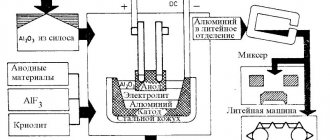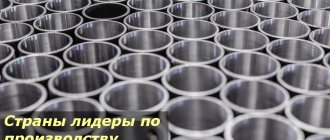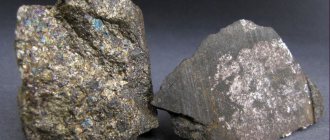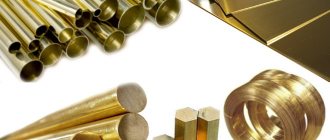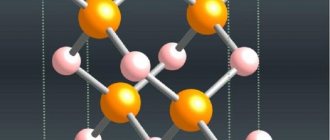History of production and use of aluminum
In the mid-19th century in Western Europe, scientists desperately tried to obtain aluminum in its pure form. In 1825, Danish explorer H.C. Oersted was the first to carry out a similar experiment using potassium in the form of an amalgam. Unfortunately, it was not possible to accurately determine the resulting substance.
However, two years later, the German scientist Wöhler became interested in obtaining aluminum. He used pure potassium to restore the metal. After 20 years of persistent searching, he managed to obtain pure aluminum in the form of granules the size of a match head. Aluminum turned out to be a beautiful and light metal, similar to silver. These properties of aluminum determined its high cost at that period of history: it was valued more expensive than gold.
At the 1855 Paris Exhibition, aluminum was the main attraction. Aluminum jewelry was placed next to the French crown diamonds. Aluminum has become a very fashionable metal. It was considered a noble element created by nature to create masterpieces of art.
Since the physical and chemical properties of aluminum were poorly studied, jewelers independently invented ways to process it. The softness and pliability of the metal allowed them to create products of any shape, make imprints of intricate patterns, and apply a variety of designs. Aluminum was coated with gold, polished, matted.
However, over time, aluminum began to go out of fashion. In the mid-1860s, a kilogram of this metal already cost only about one hundred old francs, compared to 3 thousand in 1854-1856.
Currently, the first aluminum products are of great value. Unfortunately, fashion fans have replaced most of them with gold, silver and other precious alloys and metals.
However, scientists were not stopped by changing fashion. In 1886, chemist Charles Martin Hall developed a cheap method for producing aluminum in large quantities. He added and dissolved a small amount of aluminum oxide in molten cryolite (a compound of aluminum with sodium and fluorine). Then, placing the mixture in a granite vessel, he passed an electric current through it. After several hours of waiting, he saw shiny “buttons” of pure aluminum at the bottom of the vessel. The Austrian engineer Karl Joseph Bayer, who was working in Russia at that time, did not stand aside and proposed a technology for producing alumina, which helped make the new method even cheaper. As a result, Bayer and Hall's version of aluminum production is still used in modern manufacturing today.
What was the first product made of aluminum - Metals, equipment, instructions
The production of aluminum products is very popular today. Designs made from this material are characterized by reliability and high strength. In addition, aluminum products are sold at low prices and have aesthetic beauty.
The main advantage of aluminum is its resistance to weathering. This makes it possible to produce various designs intended for installation outdoors.
Elements of aluminum structures are very light. Painting aluminum products does not require the same frequency as, for example, wooden products.
This material is very elastic, which allows the product to take different shapes.
Advantages of aluminum
The main properties and characteristics of aluminum include:
- high resistance to corrosion;
- aluminum metal products can be installed in rooms and buildings with high levels of humidity;
- any aluminum products have high decorative and aesthetic properties;
- wide selection of shades and tones;
- durability;
- choice of different surfaces, for example, matte or mirror;
- resistance to scratches, cracks, abrasions and other mechanical damage.
Application of aluminum
The first product made of aluminum back in the 19th century was a rattle. Since then, the metal has been used in various fields of life. Aluminum is often used as a material for the production of structures.
Products made from aluminum sheets are used as roofing and cladding materials. The non-toxicity of the metal determined the popularity of the production of aluminum cookware and foil used in the food industry. The only disadvantage of the material is that it is quite fragile.
Therefore, a certain amount of zinc or copper is added to its composition to strengthen the structure.
One of the properties of aluminum is electrical conductivity. It is comparable to copper, however, aluminum as a manufacturing material is cheaper. This explains the use of the material in the electrical industry in the manufacture of wires and cables.
Aluminum is also used to produce chips for electrical engineering. True, the structural features of the metal interfere with its soldering.
Aluminum is successfully used for the production of thermal equipment.
The transport industry also cannot do without the use of this material.
Aluminum parts are used in aircraft and shipbuilding. Aluminum alloys are excellent for the manufacture of ship hulls, superstructures, special equipment and mechanisms. Welded aluminum products are also very popular in construction.
Aluminum production
Aluminum does not occur in nature in its pure form. The method of its production was discovered at the end of the 19th century and has remained virtually unchanged since then. The metal is obtained by processing bauxite, a special rock whose deposits are located in the tropics.
Equipment for aluminum production includes special crushers, which are used to grind bauxite. Bauxite sand is dried and ground in mills with a small amount of water. The resulting thick mass is collected in vessels and heated by steam. In this way, silicon is removed from the mass.
Primary aluminum is cast into molds after hydrolysis. It is either sent for sale or continues further for the production of specific parts and products. At the end of its life cycle, an aluminum product can be recycled to create a new part.
Where to place an order
It is worth mentioning that the cost of aluminum products is significantly lower than that of products made from most other materials. At the same time, the low cost does not in any way affect the quality of the material.
Today, custom-made aluminum products are sold in many stores, including via the Internet. The most popular is seeking services from private workshops. This helps to fully control the product manufacturing process. Private workshops carry out orders according to original sketches and drawings provided by the customers themselves.
In private workshops, you can also submit an application for a product via email or the official website of the enterprise. This is very convenient as it saves the client’s time.
You can also discuss all the nuances of the order and determine the cost of the work in advance.
Return to list
Aluminum smartphones: Apple and others
It doesn't matter what kind of smartphone you have - iPhone, Samsung or Lenovo, no one will argue that Apple's metal - aluminum - iPhones are the coolest.
To be fair, we must admit that back in the late 1990s, Motorola was the first to use aluminum profiles in the metal body design of its Razr mobile phones.
Steve Jobs - the man who made aluminum fashionable
However, the legendary Steve Jobs and the great Apple were the first to put aluminum at the very center of the design of their metal laptops, iPhones, iPads and iPods, as well as their Watch Sport smartwatches. Back in 2008, Apple presented its concept of the unibody - a metal case for a Macbook laptop made from a single piece of extruded aluminum profile.
It was Steve Jobs who made aluminum smartphones and laptops fashionable and prestigious.
He was such a fan of aluminum that he ordered himself an aluminum yacht, which, unfortunately, was built only a year after his death, in 2012.
The design and construction of this aluminum yacht, named "Venus", follows the same minimalist spirit that Jobs promoted at Apple. It also looks like it's made from one piece of aluminum.
Steve Jobs' aluminum yacht in a Dutch ship dock
Metal smartphones from HTC, Nokia and Samsung
NTS recently released its metal - aluminum - phone, the One. Its metal body is made from a solid aluminum billet - a piece of extruded aluminum profile.
Nokia also plans to release its metal model, made of aluminum, of course, a model called Catwalk.
Samsung has traditionally been committed to plastic in the designs of its smartphones. However, he is already preparing his aluminum “smart phones”. The current Galaxy S4 model still has a plastic body, but subsequent models such as the Galaxy Note and Galaxy S6 already have a metal body made of aluminum alloy.
Aluminum notebooks (laptops, laptops)
Many companies have followed Apple's example and are increasingly using aluminum in the construction of laptops (or laptops, or better yet, laptops) instead of traditional plastic or painted metal.
In its new Chromebook Pixel laptop, Google uses a metal - aluminum - body, which is machined from a single extruded aluminum billet. This is a direct follower and competitor of the famous Macbook the unibody laptop design, which Apple developed back in 2008.
Samsung and Sony also already produce their own aluminum laptops.
The best metal for a smartphone is aluminum
Why did Apple's competitors hesitate for so long to use aluminum in their products and suddenly become interested in it? Experts find at least two explanations for this.
Improving the properties of aluminum
The new material, which could now be used in industry, was good for everyone. However, it has been noted that pure aluminum is not strong enough for some applications.
The German chemist Alfred Wilm joined the fight against this problem by alloying it with small amounts of magnesium, copper and manganese. The resulting alloy was so strong that in 1911, a batch of material was produced in the town of Durene, named duralumin in its honor. A little later, in 1919, the first aircraft was made from it. Thus aluminum triumphantly conquered the whole world.
Currently, it is difficult to name an industry that can do without this light silver metal. Aluminum, which ranks third in concentration in the earth's crust after oxygen and silicon, is attracting the attention of specialists with renewed vigor as the metal of the future. The combination of its advantages, such as low density, high thermal and electrical conductivity, strength characteristics, as well as high corrosion resistance and manufacturability, make aluminum one of the most valuable materials on the planet.
What was the first product made from aluminum?
April 25, 2022 at 4:01 pm
Life.ru talks about where else aluminum can be used.
In the automotive industry and transport
Today, new Range Rover and Jaguar models feature 81% aluminum in their body structure. The first experiments with aluminum bodies are usually attributed to Audi, which presented the A8 made of light alloys in 1994.
However, back in the early twentieth century, this light metal on a wooden frame was the signature body style of the famous British sports cars Morgan.
The real “aluminum invasion” into the auto industry began in the 1970s, when factories began to massively use this metal for engine cylinder blocks and gearbox housings instead of the usual cast iron; a little later, light alloy wheels became widespread instead of stamped steel ones.
These days, the key trend in the auto industry is electricity. And light alloys based on aluminum are becoming particularly relevant in bodybuilding: the “energy-saving” metal makes the electric vehicle lighter, which means it increases the mileage on a single battery charge. Aluminum bodies are used by the Tesla brand, a trendsetter in the car market of the future, and that, in fact, says it all!
There are no domestic cars with aluminum bodies yet. But stainless and lightweight material is already beginning to penetrate the Russian transport sector.
A typical example is the ultra-modern Vityaz-M high-speed trams, whose interiors are entirely made of aluminum alloys, which are practically eternal and do not require constant touch-up.
It is worth noting that the creation of one tram interior requires up to 1.7 tons of aluminum, which is supplied by Krasnoyarsk Aluminum.
“The ceiling, walls, racks are all aluminum.
And this is not just sheathing with sheets, the details are complex, combining finishing and load-bearing elements, and tunnels for ventilation and wiring,” says Vitaly Dengaev, general director, where the aluminum interiors of the Vityaz were created. “Plus, in addition to aesthetics, we also get the highest safety: unlike plastics and synthetics, the aluminum interior does not emit harmful substances if a fire occurs!”
On March 17 of this year, 13 Vityaz-M trams began running around Moscow and by April 5 they had already transported the first hundred thousand passengers! This fast and silent city transport with cabins for 260 people, with Wi-Fi, climate control, places for disabled people and strollers and other comfort elements, is designed for a service life of 30 years, which is twice as long as previous models. In the next three years, the capital will receive 300 Vityaz, 100 of which will be on the rails this season.
In the printers of the future
Elementary amateur 3D printers printing from plastic filament will no longer surprise anyone. Today begins the era of full-fledged serial 3D printing of metal parts.
Aluminum powder is perhaps the most common material for a technology called AF (from Additive Fabrication).
Additive in English is “additive”, and this is the deep meaning of the name of the technology: the part is not produced from a blank, from which excess material is cut off during processing, but, on the contrary, by adding material to the working area of the tool.
The metal powder comes out of the AF machine's dispenser and is laser sintered layer by layer into a single, strong mass of monolithic aluminum.
Parts that are made integral using the AF method amaze the imagination with their spatial complexity; It is impossible to perform them using classical methods even on the most modern metalworking machines! Due to the openwork design, parts created on additive printing machines from aluminum alloy powders have the strength of a monolith, while being several times lighter. They are produced without waste and quickly - such metal “laces” are indispensable in biomedicine, aviation and astronautics, precision mechanics, in the manufacture of molds, and so on.
Until recently, all technologies related to Additive Fabrication were foreign. But now domestic analogues are actively developing.
For example, at the Ural Federal University (Ural Federal University) an experimental installation for the production of metal powders for AF-3D printing is being prepared.
The installation operates on the principle of spraying molten aluminum with a jet of inert gas; this method will make it possible to obtain metal powders with any specified grain size parameters.
Development of metallurgy in Russia
Metals have been known in Russia since ancient times. Even the Scythians were known as skilled metallurgists. Products made of iron, copper and gold by Scythian craftsmen have survived to this day. Our relatively close ancestors, the Slavs, were famous for using a special alloy of iron - club.
However, metallurgy on an industrial scale has not been present in Russia for a long time. Its appearance began with the reforms of Peter I. For the needs of the army under construction and to reduce the country's dependence on foreign goods, Peter I ordered the construction of new metallurgical plants. The development of the Urals began. For a long time, the emphasis was on iron and steel (iron and steel production).
The reform of 1861, which abolished serfdom, was half-hearted. Numerous feudal ruins remain in the country's economy. As a result, the development of capitalist conditions in the economy was significantly hampered. Therefore, Russia, although possessing significant natural resources, has lagged behind in economic development. In economic development it was inferior to leading European countries.
With the beginning of the development of the young Soviet state, a course was laid for the industrialization of the economy. This meant the development of domestic industry. First of all, this concerned heavy industry: metallurgy, heavy engineering and energy. In a short time, the young state managed to create a modern economic complex, which became the basis of the economic power and political independence of the country.
But in the pre-war period, leadership in the metallurgical complex still belonged to ferrous metallurgy. The development of aviation and equipment production (especially radio technology) stimulated the rapid development of non-ferrous metallurgy. These industries have become the main consumers of non-ferrous metals.
After Belovezhskaya Pushcha
By the early 1990s, the domestic aluminum industry was one of the most successful and developed in the country. However, subsequent events jeopardized everything that had been achieved over half a century. The collapse of the planned economy led to a reduction or complete cessation of aluminum consumption in the military-industrial complex and mechanical engineering - the two main customers for the country's aluminum smelters. By 1994, aluminum consumption per capita decreased by 8.5 times compared to 1985. Sales of the “winged metal” were almost completely reoriented abroad.
Another blow was dealt to the raw material supply of the aluminum industry: after the collapse of the USSR, more than half of alumina production ended up abroad. The rest could meet the needs of Russian aluminum smelters only by 40%.
However, the most serious risk for the future of the Russian aluminum industry was associated with the outbreak of the so-called “aluminum wars”. The country's aluminum smelters came under the control of organized crime, which fought very brutally for its influence. The contract killings and reprisals that took place in the aluminum centers of Siberia left behind entire cemeteries of criminal authorities and their henchmen.
For almost a decade, the Russian aluminum industry plunged into a “black hole”, sucking everything valuable out of it and turning the country into a raw material appendage to the developed economies of the world.
The beginning of the development of the aluminum industry in Russia
Pre-revolutionary Russia did not have its own aluminum industry. However, at the end of the last century and at the beginning of this century, Russian scientists (N.N. Beketov, P.P. Fedotiev, N.A. Pushin, D.A. Penyakov, E.I. Zhukovsky, etc.) conducted a number of studies, who played an important role in the development of the global aluminum industry. Under the leadership of P.P. Fedotiev carried out in-depth studies of the theoretical foundations of aluminum electrolysis, in particular, the double systems of sodium fluoride and cryolite-aluminum, the phenomena of aluminum solubility in the electrolyte, the anode effect and some other processes associated with the electrolysis of cryolite-aluminum melts were studied. The results of these studies were world famous.
In 1882-1892. chemist K.P. Bayer developed the alkaline alumina process in Russia, which remains fundamental to the global aluminum industry. In 1895, D. A. Penyakov proposed a method for extracting alumina from bauxite by sintering with sodium sulfate in the presence of coal, and in 1915, A. N. Kuznetsov and E. I. Zhukovsky. — A method for producing alumina from low-grade ores by reduction smelting to slag aluminates of alkaline earth metals. In 1914 N.A. Pushin and his associates were the first in our country to obtain aluminum of “Russian origin”, i.e. from domestic raw materials and materials.
Only after the Great October Socialist Revolution did conditions appear in our country for the emergence of the aluminum industry, which was the main consumer of electricity. The decisive role in this process was played by the GOELRO plan, developed in 1920 on the initiative and under the leadership of V.I. Lenin, who laid the foundation for the creation of a strong energy base in our country. The first large hydroelectric power station on the Volkhov River, built in 1926 according to the GOELRO plan, became the energy base of the first aluminum smelter in the USSR - Volkhovsky. In December 1927, the 15th Congress of the All-Union Communist Party of Bolsheviks adopted a resolution on the creation of the aluminum industry in our country, and in August 1929, the Council of Labor and Defense adopted a resolution on the construction of the Volkhov and Dnieper aluminum smelters. In 1929, at the Leningrad experimental plant under the leadership of P.P. Fedotiev, many years of production tests were carried out on the production of aluminum using the electrolytic method from domestic materials. In 1930, a pilot plant was put into operation in Leningrad, which played an important role in the development of the Soviet aluminum industry. Here equipment was tested, production methods were mastered, workers, engineers and technicians were trained for the first Soviet aluminum smelters. At the same time, research was carried out on the production of electrode products necessary for the production of aluminum. The results of these studies formed the basis for the construction of the first electrode factories - factories in Moscow and Dnepropetrovsk. The method for producing cryolite developed at the Institute of Applied Mineralogy served as the basis for designing the production of cryolite at the Polevsky Cryolite Plant.
For the front and for Victory
However, a year later the war began. The Volkhov aluminum smelter and the Tikhvin alumina refinery were transported to the Urals - to Sverdlovsk, Kamensk-Uralsky and to the construction site of the new Bogoslovsky aluminum smelter. On January 7, 1943, the first aluminum plant in Siberia - Novokuznetsk (at that time - Stalinsky) began operating. The Bogoslovsky Aluminum Plant is actually the same age as our Victory: it was launched on May 9, 1945.
A well-thought-out industrial policy - even in the harsh conditions of the war economy - bore fruit: during the Great Patriotic War, aluminum production in the USSR not only did not decrease, but, on the contrary, increased. Supplies of the “winged metal” ensured the uninterrupted operation of the country’s military-industrial complex, primarily the aviation and shipbuilding industries.
Popular message topics
- The work of Vladimir Soloukhin
Vladimir Alekseevich Soloukhin is a famous Soviet poet and writer, one of the most significant representatives of “village prose”. - Pacific Ocean
The Pacific Ocean is the deepest. The average depth of this ocean is about 4 kilometers, and the deepest point is the Mariana Trench, its depth is about 11 kilometers. Also the Pacific Ocean is the largest. It occupies half of the entire World Ocean and a third of the total - External computer memory
External computer memory is usually called memory for long-term storage of information of various forms. This type of memory is not processor dependent.
Application
Aluminum is used in metallurgy as a base for alloys (duralumin, silumin) and an alloying element (alloys based on copper, iron, magnesium, nickel). Aluminum alloys are used in everyday life, in architecture and construction, in shipbuilding and automotive industry, as well as in space and aviation technology. Aluminum is used in the production of explosives. Anodized aluminum (coated with colored films of aluminum oxide) is used to make jewelry. Metal is also used in electrical engineering.


